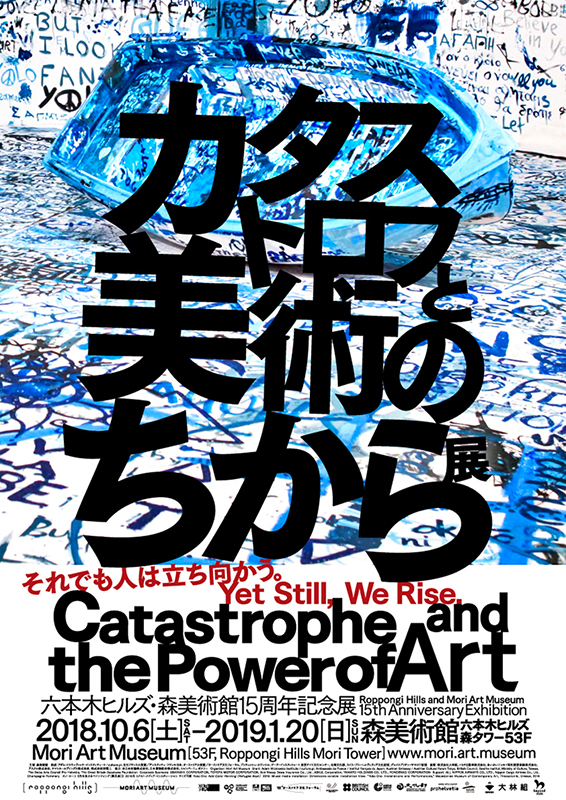Koki Tanaka: Catastrophe and the Power of Art (Mori Art Museum, Tokyo)
6 Oct 2018 – 20 Jan 2019
Roppongi Hills and Mori Art Museum 15th Anniversary Exhibition
Catastrophe and the Power of Art
Period:
2018.10.6 [Sat] – 2019.1.20 [Sun]
Open everyday
Open Hours:
10:00-22:00 (Last Admission: 21:30)
* 10:00-17:00 on Tuesdays (Last Admission: 16:30)
* January 1 [Tue], 2019 open until 22:00 (Last Admission: 21:30)
Venue*
Mori Art Museum (53F, Roppongi Hills Mori Tower)
Admission:
Adult 1,800 yen
University / Highschool student 1,200 yen
Child (Age 4 up to Junior highschool student) 600 yen
Senior (Ages 65 & over) 1,500 yen
More info: https://www.mori.art.museum
Artists & Projects:
* In alphabetical order of artists’ (sur)names / project titles
Shiva Ahmadi
Ai Weiwei
Miroslaw Balka
Ban Shigeru
Miriam Cahn
CATPC in collaboration with Renzo Martens
Sheba Chhachhi
Chim ↑ Pom
Thomas Demand
Christoph Draeger
Fujii Hikaru
Felix Gonzalez-Torres
Hatakeyama Naoya
Mona Hatoum
Hirakawa Kota
Thomas Hirschhorn
Horio Sadaharu
Khaled Hourani
Huang Hai-Hsin
HYOGO AID ’95 by ART (*)
Ikeda Manabu
Isaac Julien
Hiwa K
Kato Tsubasa
Oliver Laric
Eva and Franco Mattes
Miyajima Tatsuo
Miyamoto Ryuji
Yoko Ono
Georges Rousse
Katerina Seda
Wolfgang Staehle
Helmut Stallaerts
Swoon
Takahashi Masako (ARTS for HOPE)
Takeda Shimpei
Tanaka Koki
Gillian Wearing
Yoneda Tomoko
Muhammad ‘Ucup’ Yusuf
* “HYOGO AID ’95 by ART” participating artists:
Akasegawa Genpei, Ay-O, Domoto Hisao, Hosoe Eiko, Imai Toshimitsu, Kano Mitsuo, Kikuhata Mokuma, Kusama Yayoi, Lee Ufan, Maeda Josaku, Moriyama Daido, Motonaga Sadamasa, Nakanishi Natsuyuki, Narahara Ikko, Noda Tetsuya, Okamoto Shinjiro, Shinohara Ushio, Shiraga Kazuo, Takamatsu Jiro, Tomatsu Shomei, Yamada Masaaki, Yokoo Tadanori, Yoshihara Hideo
Recent decades have seen a stream of catastrophes around the world – from 9.11 in 2001 to the global financial crisis of 2008, the Great East Japan Earthquake in 2011, and the list goes on – and many artists have produced works dealing with these tragic events, in an endeavor to inform the wider world of them, and ensure their stories are passed down to future generations. Unlike media coverage, with its emphasis on objectivity, such documenting from a personal perspective presents to us another kind of truth, difficult to discern in the shadow of numerically overwhelming public opinion. Such works may also be designed to expose contradictions and cover-ups in wider society, or express personal loss and grief.
Catastrophe and crisis can drive us to despair, yet it is also true that the energy released as we try to recover can simultaneously spark imagination, and boost creative output. The large cohort of artists from Japan and elsewhere is working for a better society since the 2011 earthquake; attempting to offer new visions, depicting ideals and hopes encompassing wishes for reconstruction and rebirth.
“Catastrophe and the Power of Art” will look at how art deals with the major catastrophes that strike communities, as well as personal tragedies, and the role art can play in our recovery; contemplating – amid today’s mounting crises of war, terrorism, burgeoning refugee numbers, and destruction of the environment – the dynamic “power of art” to turn negative into positive.
